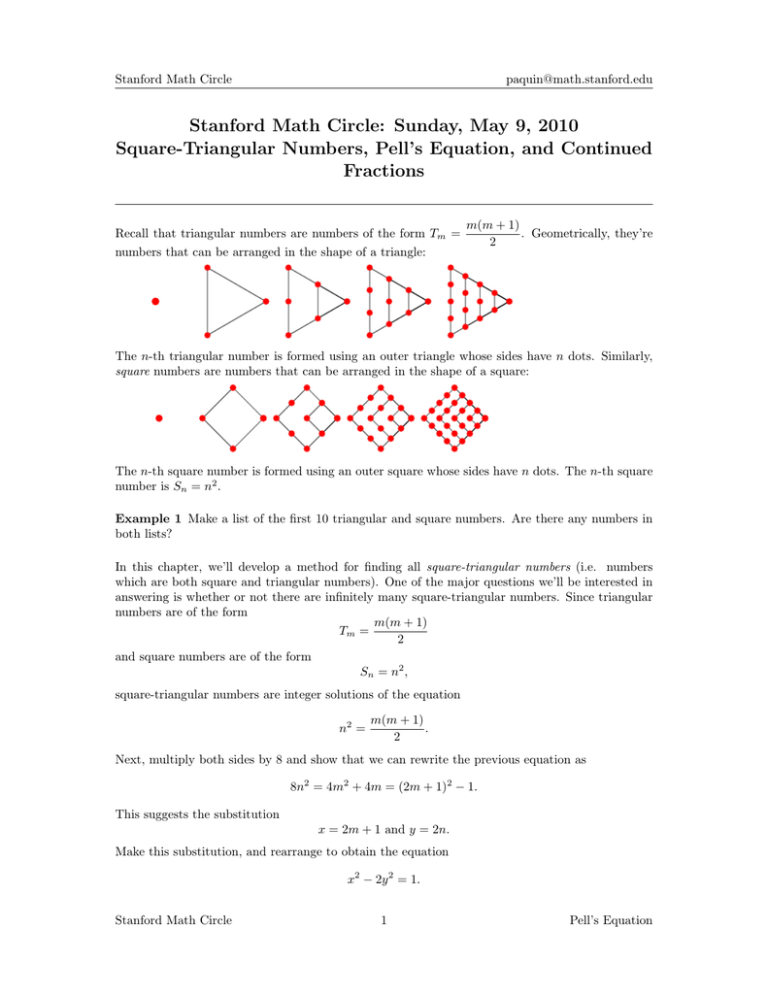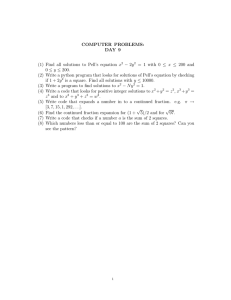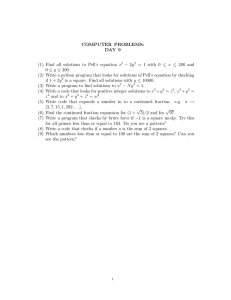Square-Triangular Numbers, Pell Equations, and Continued Fractions
advertisement

Stanford Math Circle paquin@math.stanford.edu Stanford Math Circle: Sunday, May 9, 2010 Square-Triangular Numbers, Pell’s Equation, and Continued Fractions Recall that triangular numbers are numbers of the form Tm = numbers that can be arranged in the shape of a triangle: m(m + 1) . Geometrically, they’re 2 The n-th triangular number is formed using an outer triangle whose sides have n dots. Similarly, square numbers are numbers that can be arranged in the shape of a square: The n-th square number is formed using an outer square whose sides have n dots. The n-th square number is Sn = n2 . Example 1 Make a list of the first 10 triangular and square numbers. Are there any numbers in both lists? In this chapter, we’ll develop a method for finding all square-triangular numbers (i.e. numbers which are both square and triangular numbers). One of the major questions we’ll be interested in answering is whether or not there are infinitely many square-triangular numbers. Since triangular numbers are of the form m(m + 1) Tm = 2 and square numbers are of the form Sn = n2 , square-triangular numbers are integer solutions of the equation n2 = m(m + 1) . 2 Next, multiply both sides by 8 and show that we can rewrite the previous equation as 8n2 = 4m2 + 4m = (2m + 1)2 − 1. This suggests the substitution x = 2m + 1 and y = 2n. Make this substitution, and rearrange to obtain the equation x2 − 2y 2 = 1. Stanford Math Circle 1 Pell’s Equation Stanford Math Circle paquin@math.stanford.edu Solutions to this equation produce square-triangular numbers with m= x−1 y and n = . 2 2 In other words, if (x, y) is a solution of the equation x2 − 2y 2 = 1, then N = n2 = y 2 is a 2 square-triangular number. Geometrically, the square has y/2 dots on a side and the triangle has (x − 1)/2 dots on the bottom row. Example 2 Show that (x, y) = (3, 2) and (x, y) = (17, 12) are both solutions of x2 − 2y 2 = 1. Then find the corresponding values of (m, n) and the resulting square-triangular numbers. Can you find any other solutions (perhaps using a calculator or computer)? To find all square-triangular numbers, we need to find all solutions of x2 − 2y 2 = 1. Observe that we can factor this equation as √ √ x2 − 2y 2 = (x + y 2)(x − y 2). For example, we can write the solution (x, y) = (3, 2) as √ √ 1 = 32 − 2 · 22 = (3 + 2 2)(3 − 2 2). Next, observe what happens if we square both sides of this equation: 1 = 12 = √ √ (3 + 2 2)2 (3 − 2 2)2 √ √ (17 + 12 2)(17 − 12 2) = 172 − 2 · 122 = Thus, “squaring” the solution (x, y) = (3, 2) produced the next solution (x, y) = (17, 12)! We call the solution (3, 2) the fundamental solution of the equation. Example 3 Cube the solution (x, y) = (3, 2), and show that you obtain the solution (x, y) = (99, 70). Which square-triangular number does this produce? What about taking the fourth power? √ Example 4 What is the solution of Pell’s equation corresponding to (3 + 2 2)16 ? What is the corresponding square-triangular number? Theorem 1 There are infinitely many square-triangular numbers. Proof. For every positive integer k, √ √ 1 = 1k = (3 + 2 2)k (3 − 2 2)k . √ By raising (3 + 2 2) to higher and higher powers, we continue to find more and more solutions to the equation x2 − 2y 2 = 1, and each new solution gives us a new square-triangular number. (Note: the technique that we have used is interesting from a number-theoretic point of view. In attempting to solve a question about integers, we’ve used irrational numbers!) Thus, there are infinitely square-triangular numbers, but it’s natural to ask at this point whether or not our procedure actually produces all of them. Stanford Math Circle 2 Pell’s Equation Stanford Math Circle paquin@math.stanford.edu Theorem 2 Square-Triangular Number Theorem. (a) Every solution (xk , yk ) in positive integers to the equation x2 − 2y 2 = 1 is of the form √ √ xk + yk 2 = (3 + 2 2)k , k = 1, 2, 3, . . . . (b) Every square-triangular number n2 = 21 m(m + 1) is given by m= xk − 1 yk and n = . 2 2 Proof. We’ve already checked (b). We just need to check that if (u, v) is any solution of x2 −2y 2 = 1, then it is of the form √ √ u + v 2 = (3 + 2 2)k for some k. To do this, we’ll use the method of descent. First, note that u ≥ 3, and if u = 3, then v = 2, so there’s nothing to check. Next, suppose that u > 3, and try to show that there must be another solution (s, t) in positive integers such that √ √ √ u + v 2 = (3 + 2 2)(s + t 2) with s < u. If (s, t) = (3, 2), then we’re done (i.e. (u, v) is of the correct form). If not, then try to find another solution (q, r) such that √ √ √ s + t 2 = (3 + 2 2)(q + r 2) with q < s. If we can do this, then we have √ √ √ u + v 2 = (3 + 2 2)2 (q + r 2), so if (q, r) = (3, 2), then we’re done. If not, we’ll apply the procedure again. Observe that this process can’t go on forever, since each time we get a new solution, the value of “x” is smaller (e.g. q < s < u. Since these values are all positive integers, they cannot get smaller forever, so the process must end in a finite number of√steps. Thus, we eventually must reach (3, 2) as a solution, √ so eventually we’re able to write u + v 2 as a power of 3 + 2 2. Thus, it remains to show that if we start with a solution (u, v) with u > 3, then we can find a solution (s, t) with the property √ √ √ u + v 2 = (3 + 2 2)(s + t 2) with s < u. To do this, multiply out the right-hand side to obtain √ √ u + v 2 = (3s + 4t) + (2s + 3t) 2. Thus, we need to solve u = 3s + 4t and v = 2s + 3t for s and t. Show that the solution is s = 3u − 4v and t = −2u + 3v. Now, there are three things left to check. We need to make sure that this (s, t) is really a solution of x2 − 2y 2 = 1, that s and t are both positive, and that s < u. For the first, just check that Stanford Math Circle 3 Pell’s Equation Stanford Math Circle paquin@math.stanford.edu s2 − 2t2 = 1 (remember that u2 − 2v 2 = 1 since (u, v) is a solution). Once we know that s and t are both positive, we can check that s < u as follows: 3u − 4v 1 2 = 3u − 4 t+ u 3 3 4 8 = 3u − t − u 3 3 1 4 = u− t 3 3 s = So it remains to make sure that s and t are both positive. First, we’ll check that s is positive: u2 = u > 1 + 2v 2 > 2v 2 √ 2v s = 3u − 4v √ > 3 2v − 4v √ = (3 2 − 4)v > 0 Finally, we’ll check that t is positive: u > 2 > 9 > 9 + 8u2 u 9u2 9u2 − 9 u2 − 1 2v 2 v t 3 > 8u2 8 2 u > 9 8 2 > u 9 2 > u 3 2 = −2u + 3v > −2u + 3 u = 0 3 This completes the descent proof. More generally, any Diophantine equation of the form x2 − dy 2 = 1, where d is a non-square positive integer is called a Pell equation. Pell’s equation has an interesting history–its first recorded appearance is in the “Cattle problem of Archimedes” (287-212 BC), in a letter sent from Archimedes to Eratosthenes. In 1880, A. Amthor, a German mathematician, showed that the total number of cattle had to be a number with 206,545 digits, beginning with 7766. Over the next 85 years, an additional 40 digits were found, but it was not until 1965 at the University of Waterloo that a complete solution was found–it took over 7.5 hours of computation on an IBM 7040 computer. However, they didn’t print out the solution, and the problem was solved a second time using a Cray-1 computer in 1981. Stanford Math Circle 4 Pell’s Equation Stanford Math Circle paquin@math.stanford.edu So, we know that if we can find one solution of a Pell equation, then we can find infinitely many. But how do we find the smallest (i.e. fundamental solution)? To answer this question, we’ll investigate the relationship between continued fractions and Pell equations. Example 5 A continued fraction is an expression of the form 4+ 1 2+ 1 7+ 13 . 210 This is called the continued fraction expansion for the fraction . Note that in the continued 47 fraction expansion, all of the denominators are equal to 1. A more compact notation for this continued fraction expansion is [4; 2, 7, 3]. Example 6 Find the continued fraction for 8/5 8 . 5 = 1 + 3/5 = 1 + 1/5/3 1 = 1+ 1 + 32 1 = 1+ 1 + 1+1 1 2 So 8 = [1; 1, 1, 2]. 5 Example 7 Consider the decimal expansion of π: π = 3.1415926535897932384626433 . . . Observe that we can write this as π = 3 + something, where the “something” is a number between 0 and 1. Next, observe that we can rewrite this as: π = 3 + 0.1415926535897932384626433 . . . 1 = 3+ 1 0.1415926535897932384626433... 1 7.06251330593104576930051 . . . 1 = 3+ 7 + 0.06251330593104576930051 . . . 1 = 3+ 7 + a little bit more = 3+ 22 The final equation above gives the fairly good approximation for π. 7 Now, if we repeat this process, we obtain: Stanford Math Circle 5 Pell’s Equation Stanford Math Circle paquin@math.stanford.edu 1 0.06251330593104576930051 . . . = 1 0.06251330593104576930051... = = 15.996594406685719888923060 15 + 0.996594406685719888923060 Thus, we have the following representation of π: π = 3+ 1 7+ 1 15+0.996594406685719888923060 The bottom level of this fraction is 15.996594406685719888923060, which is very close to 16. If we replace it with 16, we get a rational number that is very close to π: 3+ 1 355 1 = 113 = 3.1415929203539823008849557 . . . 7 + 16 355 The fraction agrees with π to six decimal places. 113 Continue this process, at each stage flipping the decimal that is left over and then separating off the whole integer part, to obtain a four-layer fraction representation of π. Use your final representation to get a rational number approximation for π, and compare with the known decimal approximation of π to see how accurate your approximation is. Using our more compact notation, we can express the continued fraction expansion of π as Using this notation, our continued fraction expansion of π can be written as π = [3; 7, 15, 1, 292, 1, 1, 1, 2, 1, 3, 1, 14, 2, 1, 1, 2, . . .]. Definition 1 The n-th convergent to α is the rational number pn = [a0 ; a1 , a2 , . . . , an ] = a0 + qn a1 + 1 1 a2 + 1 a3 +···+ 1 an obtained by using the terms up to an in the continued fraction expansion of α. Example 8 For the continued fraction expansion of π = [3; 7, 15, 1, 292, 1, 1, 1, 2, 1, 3, 1, 14, 2, 1, 1, 2, . . .], the first few convergents are: p0 q0 p1 q1 p2 q2 = 3 = 3+ = 1 22 = = 3.142857143 7 7 1 333 3+ 1 = 106 = 3.141509434 7 + 15 Consider again the Pell equation with d = 2: x2 − 2y 2 = 1. Stanford Math Circle 6 Pell’s Equation Stanford Math Circle paquin@math.stanford.edu √ Start by finding the continued fraction expansion of 2 = 1.414213562...: √ 2 = [1; 2, 2, 2, 2, 2, 2, 2, . . .]. The first few convergents are: p0 q0 p1 q1 p2 q2 = 1 = 1+ = 1 3 = 2 2 1 7 1+ = 5 2 + 12 What do you notice? The fundamental solution of x2 − 2y 2 = 1 is (3, 2), which is one of our convergents! Theorem 3 Continued Fractions and Fundamental Solutions of Pell Equations. Consider hi the Pell equation x2 − dy 2 = 1. Let , i = 0, 1, . . . denote the sequence of convergents to the ki √ continued fraction expansion for d. Then the fundamental solution (x1 , y1 ) of the Pell equation satisfies x1 = hi and y1 = ki for some i. Example 9 Consider the Pell equation x2 − 3y 2 = 1. Find the continued fraction expansion of √ 3 = 1.7320508075688..., and use it to find the fundamental solution of the Pell equation. √ 3 p0 q0 p1 q1 p2 q2 = [1; 1, 2, 1, 2, 1, 2, 1, 2, . . .] = 1 = 1+ = 1 2 = 1 1 1 5 1+ = = 1.6666... 3 1 + 12 Example 10 Consider the Pell equation x2 − 7y 2 = 1. Find the continued fraction expansion of √ 7 = 2.6457513110645907..., and use it to find the fundamental solution of the Pell equation. √ 7 p0 q0 p1 q1 p2 q2 p3 q3 = [2; 1, 1, 1, 4, 1, 1, 1, 4, 1, 1, 1, 4, . . .] = 2 = 2+ = = 1 3 = 1 1 1 5 = = 2.5 2+ 2 1 + 11 1 8 2+ = = 2.6666... 3 1 + 1+1 1 1 Stanford Math Circle 7 Pell’s Equation




